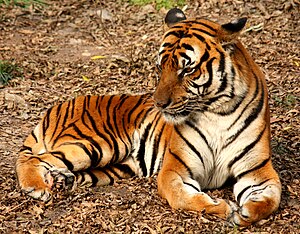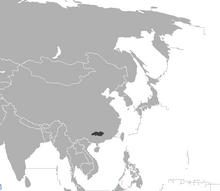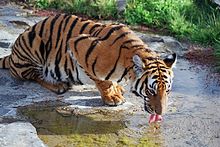South China tiger
| South China tiger | ||||||||||||
|---|---|---|---|---|---|---|---|---|---|---|---|---|

South China tiger in Shanghai Zoo |
||||||||||||
| Systematics | ||||||||||||
|
||||||||||||
| Scientific name | ||||||||||||
| Panthera tigris amoyensis | ||||||||||||
| ( Hilzheimer , 1905) |
The South China tiger ( Panthera tigris amoyensis ), also known as the Amoy tiger , is a very rare subspecies of the tiger . According to the WWF, there are only a few isolated individuals left in the wild, if at all. It has not been sighted scientifically for several decades.
features
The South China tiger is smaller than, for example, King and Indochinese tigers , whose habitats are geographically closest.
anatomy
The total length of large males is on average 250 to 265 cm, that of the females is 230 to 240 cm. The head-torso length of the males is about 160 to 175 cm. The heaviest known male weighed 175 kg, with an average weight of 140 to 145 kg. As with other tigers, the males are slightly larger and heavier than the females, who only weigh 100 to 115 kg.
hide
The fur is redder than that of the King Tiger . The white on the face and underside is also less extensive and turns creamy in some animals. The wide, deep black stripes are relatively far apart. They are usually double on the flanks and often break up into spots at the lower end. The tail rings are also wide and often double. The South China tiger very rarely shows elongated neck hair, as is occasionally found in other subspecies. The fur is as long as that of the Bengal tiger, but the winter fur can be a little longer in the northern populations.
distribution
The Chinese tiger was originally common in most of China. The northern border, where he was replaced by the Amurtiger , was about 40 degrees latitude. In the south it struck the area of the Indochina tiger in northern Guangxi , Yunnan and Guangdong , in the west it penetrated along the mountain valleys far into western central China. Today the subspecies only lives in the mountains of the Chinese provinces of Guangdong , Fujian , Hunan , Jiangxi and Zhejiang . At the beginning of the 20th century it was still widespread in large parts of southern China. In 1949 there were an estimated 4,000 animals of this subspecies. The often quoted number of 20 to 30 specimens in South China is no longer confirmed by experts ( cf. Ron Tilson, The Tiger Foundation ), since there have been no verifiable sightings in the last few decades. An extensive Sino-US field study in 2001-2002 found no evidence of wild tiger survival for the past 10 years in eight reservations in five provinces identified by the Chinese authorities as the most likely survival areas for tiger populations. The forest areas with an average size of around 100 km², which were designated as tiger reserves, were also judged to be too small to allow even a small number of animals to survive, since these protected areas are also disturbed by commercial forest use and agriculture. On the Red List of endangered species of the IUCN this subspecies as being Sumatran tiger , with the feature CR ( critically endangered - in danger of extinction) conducted and information supplied by Ron Tilson cited.
The Chinese tiger is the most critically endangered of all tiger subspecies; some experts believe that it is already extinct in the wild. China has taken protective measures, but they came too late and relate to territories that are too small and too far apart.
About 60 individuals live in the zoos in China. Information on the number of specimens kept in foreign zoos cannot be researched.
Sightings
In October 2007, pictures of a wild tiger were distributed, it would have been the first sighting since 1964. In June 2008, however, the recordings were exposed as falsifications and 13 officials were arrested in connection with them.
Planned release
A group of animal rights activists is aiming to get South China tigers used to a life in the wild again. For this purpose, the Save Chinas Tigers Foundation was founded in 2001 by the environmentalist and former fashion designer Li Quan together with an international group of investors and experts. Save Chinas Tigers brought South Chinese tigers kept in human custody (zoos, animal parks) to South Africa in the Laohu Valley Reserve , where attempts to reintroduce into a suitable territory are undertaken at great expense. The aim is to get these animals used to hunting again, to raise offspring and to reintroduce a certain number of tigers to the wild in China.
Initially (September 2003) two South Chinese tigers were brought from China to South Africa in the reserve, which could be successfully introduced to independent hunting and killing of prey. In October 2004, two more specimens from a Chinese zoo followed, which were relocated to the reserve. Two of the originally four South China tigers that were relocated to South Africa gave birth to two young each (2007 and 2008). However, one of these boys died of a bacterial infection ; one of the specimens brought to South Africa in 2003 died of a heart defect. In 2009 two more boys were born. These are raised by the mother completely self-sufficient and without human support in the wilderness of the reserve. This makes it possible for these young animals to be introduced to natural hunting by their mothers and to learn this. Not least because of this, the program is rated as a success.
However, there are difficulties in bringing more young South China tigers to South Africa, as hardly any offspring are born in captivity in China.
etymology
The zoological term Panthera tigris amoyensis has its origin in the Chinese city of Amoy . Amoy referred further a dialect of Fujian -Provinz and the city of Xiamen (Fujian Province) is spoken. The South Chinese or Amoytiger was formerly widespread in these provinces.
literature
- Qiu-Hong Wan et al .: Use of oligonucleotide fingerprinting and faecal DNA in identifying the distribution of the Chinese tiger ( Panthera tigris amoyensis Hilzheimer) . Biodiversity and Conservation, Springer Netherlands, Volume 12, Number 8 / August, 2003. online-PDF
- Vratislav Mazák : The tiger . Reprint of the 3rd edition from 1983. Westarp Sciences Hohenwarsleben, 2004 ISBN 3-89432-759-6
swell
- ↑ Tilson R., H. Defu, Muntifering J. Nyhus P .: Dramatic decline of wild South China tigers Panthera tigris amoyensis : Field survey of priority tiger reserves . In: Oryx . tape 38 , no. 1 , 2004, p. 40-47 , doi : 10.1017 / S0030605304000079 (English).
- ^ The IUCN Red List - Panthera tigris amoyensis
- ↑ Faked term snaps (Engl.)
- ↑ Save Chinas Tigers ( Memento of the original from October 21, 2010 in the Internet Archive ) Info: The archive link was inserted automatically and has not yet been checked. Please check the original and archive link according to the instructions and then remove this notice. (engl.)
- ↑ South China Tiger ( Memento of the original from October 23, 2007 in the Internet Archive ) Info: The archive link was inserted automatically and has not yet been checked. Please check the original and archive link according to the instructions and then remove this notice. on savethetigerfund.org; Section: Captive Breeding
- ↑ Save China's Tigers - History (Engl.)
- ↑ See definition of terms at www.lingoz.com

